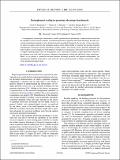| dc.contributor.author | Biamonte, Jacob D. | |
| dc.contributor.author | Morales, Mauro E. S. | |
| dc.contributor.author | Koh, Dax Enshan | |
| dc.date.accessioned | 2020-05-21T20:20:00Z | |
| dc.date.available | 2020-05-21T20:20:00Z | |
| dc.date.issued | 2020-01 | |
| dc.date.submitted | 2019-08 | |
| dc.identifier.issn | 2469-9926 | |
| dc.identifier.issn | 2469-9934 | |
| dc.identifier.uri | https://hdl.handle.net/1721.1/125396 | |
| dc.description.abstract | A contemporary technological milestone is to build a quantum device performing a computational task beyond the capability of any classical computer, an achievement known as quantum adversarial advantage. In what ways can the entanglement realized in such a demonstration be quantified? Inspired by the area law of tensor networks, we derive an upper bound for the minimum random circuit depth needed to generate the maximal bipartite entanglement correlations between all problem variables (qubits). This bound is lattice geometry dependent and makes explicit a nuance implicit in other proposals with physical consequence. The hardware itself should be able to support superlogarithmic ebits of entanglement across some poly(n) number of qubit bipartitions; otherwise the quantum state itself will not possess volumetric entanglement scaling and full-lattice-range correlations. Hence, as we present a connection between quantum advantage protocols and quantum entanglement, the entanglement implicitly generated by such protocols can be tested separately to further ascertain the validity of any quantum advantage claim. | en_US |
| dc.publisher | American Physical Society (APS) | en_US |
| dc.relation.isversionof | http://dx.doi.org/10.1103/PhysRevA.101.012349 | en_US |
| dc.rights | Article is made available in accordance with the publisher's policy and may be subject to US copyright law. Please refer to the publisher's site for terms of use. | en_US |
| dc.source | American Physical Society | en_US |
| dc.title | Entanglement scaling in quantum advantage benchmarks | en_US |
| dc.type | Article | en_US |
| dc.identifier.citation | Biamonte, Jacob D., Mauro E. S. Morales, and Dax Enshan Koh. "Entanglement scaling in quantum advantage benchmarks." Physical Review A, 101, 1 (January 2020): 012349. © 2020 American Physical Society | en_US |
| dc.contributor.department | Massachusetts Institute of Technology. Department of Mathematics | en_US |
| dc.relation.journal | Physical Review A | en_US |
| dc.eprint.version | Final published version | en_US |
| dc.type.uri | http://purl.org/eprint/type/JournalArticle | en_US |
| eprint.status | http://purl.org/eprint/status/PeerReviewed | en_US |
| dc.date.updated | 2020-01-31T15:41:08Z | |
| dc.language.rfc3066 | en | |
| dc.rights.holder | American Physical Society | |
| dspace.date.submission | 2020-01-31T15:41:08Z | |
| mit.journal.volume | 101 | en_US |
| mit.journal.issue | 1 | en_US |
| mit.license | PUBLISHER_POLICY | |
| mit.metadata.status | Complete | |
